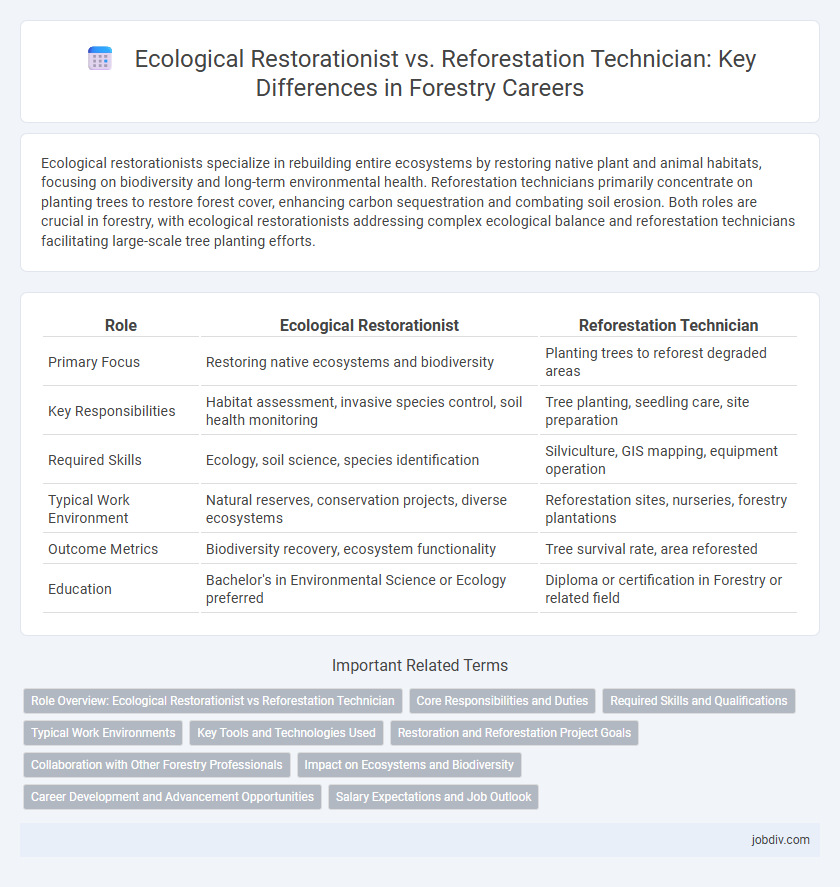Ecological restorationists specialize in rebuilding entire ecosystems by restoring native plant and animal habitats, focusing on biodiversity and long-term environmental health. Reforestation technicians primarily concentrate on planting trees to restore forest cover, enhancing carbon sequestration and combating soil erosion. Both roles are crucial in forestry, with ecological restorationists addressing complex ecological balance and reforestation technicians facilitating large-scale tree planting efforts.
Table of Comparison
| Role | Ecological Restorationist | Reforestation Technician |
|---|---|---|
| Primary Focus | Restoring native ecosystems and biodiversity | Planting trees to reforest degraded areas |
| Key Responsibilities | Habitat assessment, invasive species control, soil health monitoring | Tree planting, seedling care, site preparation |
| Required Skills | Ecology, soil science, species identification | Silviculture, GIS mapping, equipment operation |
| Typical Work Environment | Natural reserves, conservation projects, diverse ecosystems | Reforestation sites, nurseries, forestry plantations |
| Outcome Metrics | Biodiversity recovery, ecosystem functionality | Tree survival rate, area reforested |
| Education | Bachelor's in Environmental Science or Ecology preferred | Diploma or certification in Forestry or related field |
Role Overview: Ecological Restorationist vs Reforestation Technician
Ecological Restorationists specialize in rehabilitating degraded ecosystems by restoring native vegetation and promoting biodiversity, often conducting soil assessments and developing long-term management plans. Reforestation Technicians focus on planting trees to replenish forest cover, maintaining seedlings, and monitoring growth to ensure forest regeneration and carbon sequestration. Both roles contribute to forest recovery, but Ecological Restorationists emphasize ecosystem health while Reforestation Technicians prioritize tree propagation and survival.
Core Responsibilities and Duties
Ecological restorationists specialize in restoring natural habitats by assessing ecosystem health, designing and implementing restoration plans, and monitoring biodiversity recovery to ensure long-term environmental stability. Reforestation technicians focus on planting trees, managing nurseries, and maintaining young forests to accelerate timber growth and carbon sequestration. Both roles require knowledge of native species and environmental conditions but differ in scope, with restorationists addressing broader ecosystem functions and technicians concentrating on tree establishment and forest management tasks.
Required Skills and Qualifications
Ecological Restorationists require advanced knowledge in ecosystem dynamics, native species identification, soil science, and environmental policy, often holding degrees in ecology or environmental science. Reforestation Technicians need practical skills in tree planting, forest management practices, use of GIS tools, and machinery operation, typically supported by certifications in forestry or natural resource management. Both roles demand strong problem-solving abilities, but Ecological Restorationists emphasize scientific research and planning, whereas Reforestation Technicians focus on fieldwork execution and maintenance.
Typical Work Environments
Ecological restorationists primarily work in diverse natural settings such as wetlands, riparian zones, and degraded ecosystems, focusing on restoring native habitats and biodiversity. Reforestation technicians are typically found in commercial tree nurseries, forest plantations, and logging sites where they assist in planting and managing young trees to replenish forest cover. Both roles require fieldwork, but restorationists emphasize ecosystem recovery while technicians concentrate on tree propagation and stand establishment in managed forests.
Key Tools and Technologies Used
Ecological Restorationists utilize GIS mapping, drone surveillance, and native seed databases to design and monitor habitat recovery projects. Reforestation Technicians rely heavily on GPS units, tree planting machines, and soil moisture sensors to efficiently plant and maintain tree seedlings. Both roles integrate remote sensing technology and data analytics to optimize forest regeneration and ecosystem health outcomes.
Restoration and Reforestation Project Goals
Ecological Restorationists prioritize restoring native ecosystems by enhancing biodiversity, soil health, and natural habitat functions to ensure long-term ecological resilience. Reforestation Technicians focus on planting and maintaining trees to recover forest cover, aiming to sequester carbon, reduce erosion, and support timber production. Both roles contribute to landscape recovery, but restoration emphasizes ecosystem complexity while reforestation targets forest canopy establishment.
Collaboration with Other Forestry Professionals
Ecological restorationists collaborate closely with soil scientists, wildlife biologists, and hydrologists to design holistic restoration plans that restore ecosystem functions and biodiversity. Reforestation technicians work alongside forestry managers and field crews to implement planting schedules, monitor tree growth, and manage pest controls, ensuring healthy forest regeneration. Both roles rely on effective communication and data sharing to align restoration goals with operational forestry practices for sustainable landscape recovery.
Impact on Ecosystems and Biodiversity
Ecological restorationists specialize in rehabilitating degraded ecosystems by reestablishing native species and natural processes, thereby enhancing biodiversity and ecosystem resilience. Reforestation technicians primarily focus on planting trees to restore forest cover, which increases carbon sequestration but may have limited impact on overall ecosystem complexity if species diversity is low. The comprehensive approach of ecological restorationists tends to result in more sustainable and diverse habitats compared to the singular tree-planting focus of reforestation technicians.
Career Development and Advancement Opportunities
Ecological Restorationists often advance by gaining expertise in ecosystem management, securing certifications such as Certified Ecological Restoration Practitioner (CERP), and leading large-scale habitat restoration projects. Reforestation Technicians progress through hands-on experience, obtaining forestry technician certifications, and moving into supervisory roles or specialized areas like seed collection and nursery management. Both careers benefit from continuous education and involvement in environmental policy development to enhance career growth and leadership opportunities.
Salary Expectations and Job Outlook
Ecological Restorationists typically earn a median salary ranging from $45,000 to $65,000 annually, driven by their expertise in habitat rehabilitation and ecosystem management. Reforestation Technicians usually have a starting salary between $30,000 and $45,000, with demand growing due to increased reforestation projects and climate change mitigation efforts. The job outlook for Ecological Restorationists shows steady growth at about 5% annually, while Reforestation Technicians experience higher growth rates near 8%, reflecting expanded environmental conservation initiatives.
Ecological Restorationist vs Reforestation Technician Infographic

 jobdiv.com
jobdiv.com